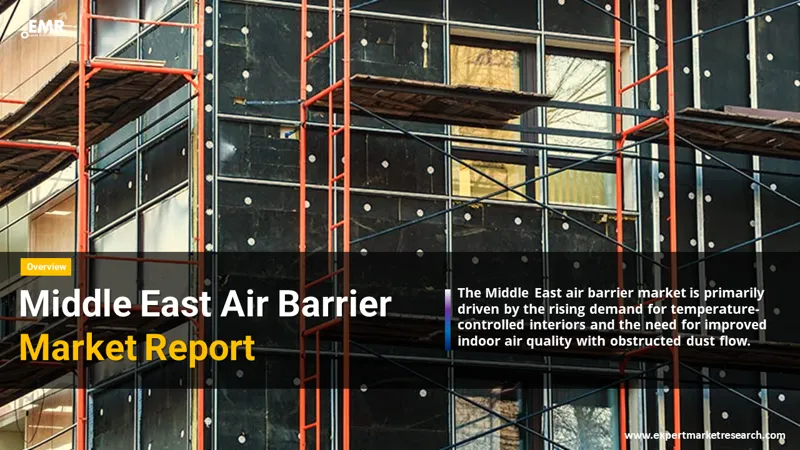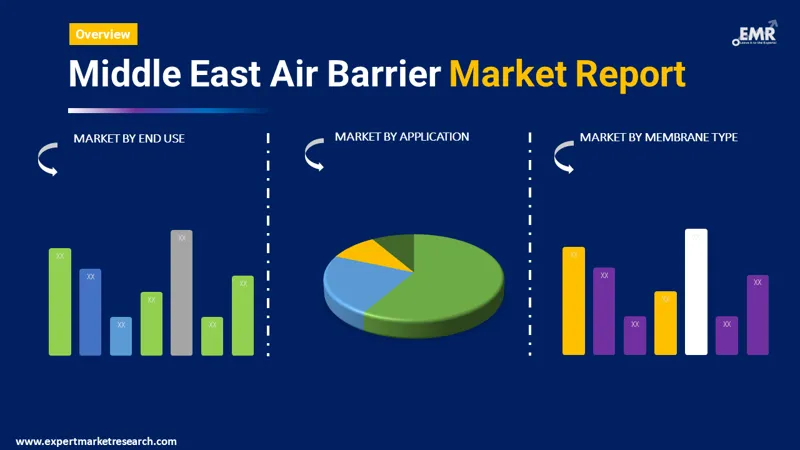
Consumer Insights
Uncover trends and behaviors shaping consumer choices today
Procurement Insights
Optimize your sourcing strategy with key market data
Industry Stats
Stay ahead with the latest trends and market analysis.
The market size for air barriers in the Middle East reached a value of more than USD 152.63 Million in 2025. The Middle East air barrier market is expected to grow at a CAGR of 5.20% between 2026 and 2035, reaching a value of USD 253.39 Million by 2035.
Base Year
Historical Period
Forecast Period
Compound Annual Growth Rate
5.2%
Value in USD Million
2026-2035
*this image is indicative*
An air barrier is a system of materials that is designed in such a way that it creates an airtight space which restricts the movement of air between a conditioned and an unconditioned space. There are numerous substances that can be used as an air barrier including films of polythene and nylon, plywood, and building wrap. Air barriers can be used in any type of building or structure.

Read more about this report - REQUEST FREE SAMPLE COPY IN PDF
The EMR’s report titled “Middle East Air Barrier Market Report and Forecast 2026-2035" offers a detailed analysis of the market based on the following segments:
Market Breakup by Membrane Type
Market Breakup by Application
Market Breakup by End Use
Market Breakup by Region

Read more about this report - REQUEST FREE SAMPLE COPY IN PDF
Sheet applied air barriers are durable, strong membranes that control moisture and air leakage in all types of assemblies of walls. However, fluid applied air barriers can adapt to complex substrate geometry which is not possible with the sheet applied air barriers. The fluid applied air barriers adhere and waterproof any wall condition such as electric conduits or brick tiles. Due to the additional advantages, fluid applied air barriers occupy a significant segment of the Middle East air barrier market.
The increase in population has increased the construction of residential buildings such as apartments, high rise buildings, and houses. Businesses are expanding resulting in an increasing construction demand for commercial buildings such as offices, malls and other properties involving business.
Meanwhile, governments are taking initiatives to build new hospitals, shelters, and other buildings to help in development. The rising economy and population in Middle East have increased the demand for public infrastructure buildings due to which it occupies a substantial share of the Middle East air barrier market.
The comprehensive EMR report provides an in-depth assessment of the market based on the Porter's five forces model along with giving a SWOT analysis. The report gives a detailed analysis of the following key players in the Middle East air barrier market covering their competitive landscape and latest developments like mergers, acquisitions, investments, and expansion plans.
Dow Inc. founded in 2019 has its headquarter in Michigan, United States. It delivers solutions for packaging and infrastructure industry by applying innovative ideas and technologies while providing robust customer care.
GCP Applied Technologies Inc. is a chemical company which was established in 2015 in Georgia, United States. They create quality construction products applying their innovative ideas for a sustainable and better future.
WR Meadows, Inc. was founded in 1926 and is headquartered in Illinois, United States. It deals with products and machines involved in construction purposes for the use by the professionals. They produce premium grade products for quality constructions.
*Please note that this is only a partial list; the complete list of key players is available in the full report. Additionally, the list of key players can be customized to better suit your needs.*
Other market players include SOPREMA, Inc., and 3M Company, among others.




*While we strive to always give you current and accurate information, the numbers depicted on the website are indicative and may differ from the actual numbers in the main report. At Expert Market Research, we aim to bring you the latest insights and trends in the market. Using our analyses and forecasts, stakeholders can understand the market dynamics, navigate challenges, and capitalize on opportunities to make data-driven strategic decisions.*
Get in touch with us for a customized solution tailored to your unique requirements and save upto 35%!
The market size of air barriers in the Middle East reached a value of more than USD 152.63 Million in 2025.
The market is expected to grow at a CAGR of 5.20% between 2026 and 2035.
The major market drivers are increased need for temperature controlled interiors, and demand for improved indoor air quality with obstructed flow of dust.
The Middle East air barrier market size is expected to reach a value of more than USD 253.39 Million in 2035.
The key trends of the market are increasing urbanisation, changing climate, and demand for eco-friendly air barriers.
Key market players are Dow Inc., GCP Applied Technologies Inc., WR Meadows, Inc., SOPREMA, Inc., and 3M Company, among others.
An air barrier is a system of materials that is designed in such a way that it creates an airtight space which restricts the movement of air between a conditioned and an unconditioned space.
There are many substances that can be used as an air barrier including films of polythene and nylon, plywood, and building wrap.
The market is segmented based on membrane type, application, end use and country.
Explore our key highlights of the report and gain a concise overview of key findings, trends, and actionable insights that will empower your strategic decisions.
| REPORT FEATURES | DETAILS |
| Base Year | 2025 |
| Historical Period | 2019-2025 |
| Forecast Period | 2026-2035 |
| Scope of the Report |
Historical and Forecast Trends, Industry Drivers and Constraints, Historical and Forecast Market Analysis by Segment:
|
| Breakup by Membrane Type |
|
| Breakup by Application |
|
| Breakup by End Use |
|
| Breakup by Region |
|
| Market Dynamics |
|
| Competitive Landscape |
|
| Companies Covered |
|
Single User License
One User
USD 3,999
USD 3,599
tax inclusive*
Datasheet
One User
USD 2,499
USD 2,249
tax inclusive*
Five User License
Five User
USD 4,999
USD 4,249
tax inclusive*
Corporate License
Unlimited Users
USD 5,999
USD 5,099
tax inclusive*
*Please note that the prices mentioned below are starting prices for each bundle type. Kindly contact our team for further details.*
Flash Bundle
Small Business Bundle
Growth Bundle
Enterprise Bundle
*Please note that the prices mentioned below are starting prices for each bundle type. Kindly contact our team for further details.*
Flash Bundle
Number of Reports: 3
20%
tax inclusive*
Small Business Bundle
Number of Reports: 5
25%
tax inclusive*
Growth Bundle
Number of Reports: 8
30%
tax inclusive*
Enterprise Bundle
Number of Reports: 10
35%
tax inclusive*
How To Order

Select License Type
Choose the right license for your needs and access rights.

Click on ‘Buy Now’
Add the report to your cart with one click and proceed to register.

Select Mode of Payment
Choose a payment option for a secure checkout. You will be redirected accordingly.
Gain insights to stay ahead and seize opportunities.

Get insights & trends for a competitive edge.

Track prices with detailed trend reports.

Analyse trade data for supply chain insights.

Leverage cost reports for smart savings

Enhance supply chain with partnerships.

Connect For More Information
Our expert team of analysts will offer full support and resolve any queries regarding the report, before and after the purchase.
Our expert team of analysts will offer full support and resolve any queries regarding the report, before and after the purchase.
We employ meticulous research methods, blending advanced analytics and expert insights to deliver accurate, actionable industry intelligence, staying ahead of competitors.
Our skilled analysts offer unparalleled competitive advantage with detailed insights on current and emerging markets, ensuring your strategic edge.
We offer an in-depth yet simplified presentation of industry insights and analysis to meet your specific requirements effectively.
Share